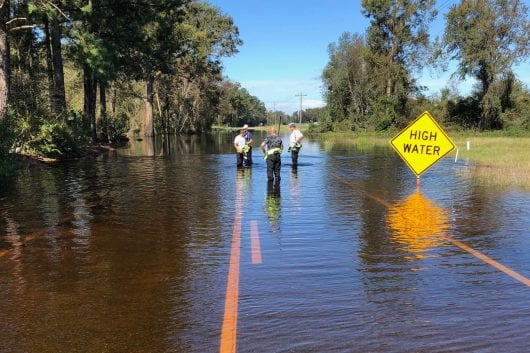
Team members of Ohio Task Force 1 assessed the flooding caused by Neuse River in Lenoir County, North Carolina. Credit: Courtesy of Daniel Bachmann
Daniel Bachmann arrived on the scene of Hurricane Florence on Sept. 12 and worked to keep his team healthy over the following days as they aided North Carolina locals.
In an effort to provide disaster relief, the Federal Emergency Management Agency deployed two Ohio Task Force 1 search-and-rescue teams to the Carolinas.
Bachmann is an emergency medicine doctor and director of emergency preparedness for the Wexner Medical Center and member of the task force who has seen hurricane relief efforts firsthand.
Bachmann’s first task force deployment to Hurricane Matthew in October 2016 combined with multiple training sessions helped him prepare for the water rescue and other relief he provided during Florence.
The task force is one of 28 urban search-and-rescue teams in the United States, totaling about 230 members. FEMA deployed two teams from Ohio, consisting of 16 members each, specifically trained in swift-water rescue.
The first team left for the Carolinas on Sept. 11, and Bachmann’s team left on Sept. 12 for Lenoir County in southeast North Carolina.
Phil Sinewe, Ohio Task Force 1 public information officer, said the team members come from many walks of life, including firefighters, canine search specialists, engineers, nurses and doctors, like Bachmann.
In the two weeks Bachmann’s team was in North Carolina, it conducted about 35 water rescues and evacuations and about the same number of domestic animal rescues. Bachmann said he also performed about 60 wellness checks for people who could not evacuate and provided bottled water to those who were isolated due to flash flooding and storm surge.
“When we arrived, [the Neuse River] was at about 9 feet, and by the time it crested, it hit about 25 feet,” Bachmann said. “It cut off a large part of the county to just about everything because roads and bridges were flooded and washed out.”
Bachmann said flooding caused extensive damage and health risk concerns throughout Lenoir County, including the volunteer fire department where the team stayed.
“We were fortunate enough to have a roof over our heads, at least. We were sleeping on cots, and we lost ability to have a bathroom and showers for most of it because the septic tank was flooded, in addition to everything else being flooded,” Bachmann said.
The impact from the flooding should not get any worse, but the lost infrastructure remains, Bachmann said. He said he thinks problems in communities hit by Florence will be facing a prolonged recovery period.
“Unfortunately, disasters are inevitable, so to a certain degree, we’re not able to prevent these things from happening, but what you can do is mitigate the impact they do have,” Bachmann said. “Even here in Ohio, have a plan for yourself and your family.”



